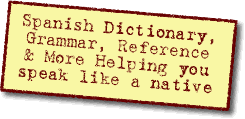Ask a Question(Create a thread) |
|
|||||||
Pronunciation of Be (b) and Ube (v)Grammar questions– conjugations, verb tenses, adverbs, adjectives, word order, syntax, etc. |
 |
|
|
Thread Tools |
|
#1
|
|||
|
|||
|
Pronunciation of Be (b) and Ube (v)
Hi people. This is driving me nuts. Could someone clarify it for me? I'm studying mainland (Castilian) Spanish. I've read what several books (and endless websites) say about the way b/v changes its pronunciation in different placings. No-one gives a complete explanation and many people are tantalizingly similar to each other, but not exactly, and everyone misses out out one combination or another in their description.
I think I've nearly worked it out, but one thing is still puzzling me ... If you have a word beginning in b/v and the previous word ends in a consonant (that is not m or n) and both words are part of a continuous phrase (if that's not a contradiction?) ... how should you pronounce this b/v? (According to some writers, it's not at the start of a phrase and is not following an 'm' or 'n', so it should be 'bv'. But according to others it is "at the start of a word" so should be hard 'b'.) Help, please!! Thank you.  David David
|
|
Get rid of these ads by registering for a free Tomísimo account.
|
|
#3
|
|||
|
|||
|
Pronunciation of Be (b) and Uve (v)
Dear Rusty. Thank you so much for your speedy and really detailed response. That leaves no room for quibbling!
 Actually, the majority of my other sources agree with your very clear statement - only a few state (or imply) that a consonant (even if not nasal) before the b/v can make it hard. I will go with what you state and take it from there.  Thanks again! David |
 |
«
Previous Thread
|
Next Thread
»
| Link to this thread | |
|
|
|||||||
 Similar Threads
Similar Threads
|
||||
| Thread | Thread Starter | Forum | Replies | Last Post |
| Pronunciation | fluffy | Technical things | 10 | April 18, 2013 05:56 AM |
| Pronunciation | Caballero | General Chat | 16 | June 21, 2011 08:30 AM |
| pronunciation | raji | Practice & Homework | 16 | July 15, 2008 08:40 AM |
All times are GMT -6. The time now is 01:36 AM.







